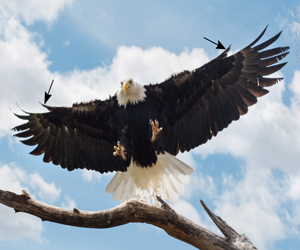Crossref Citations
This article has been cited by the following publications. This list is generated based on data provided by
Crossref.
Linehan, Thomas
and
Mohseni, Kamran
2020.
Scaling trends of bird’s alular feathers in connection to leading-edge vortex flow over hand-wing.
Scientific Reports,
Vol. 10,
Issue. 1,
Lin, Yanpi
Li, Xiaojun
Zhu, Zuchao
Wang, Xunming
Lin, Tong
and
Cao, Haibin
2021.
An Energy Consumption Improvement Method for Centrifugal Pump Based on Bionic Optimization of Blade Trailing Edge.
SSRN Electronic Journal ,
Bao, Han
Song, Bifeng
Yang, Wenqing
and
Xue, Dong
2021.
The function of the alula with different geometric parameters on the flapping wing.
Physics of Fluids,
Vol. 33,
Issue. 10,
Bao, Han
Song, Bifeng
Yang, Wenqing
Xuan, Jianlin
and
Xue, Dong
2021.
The Progress of Aerodynamic Mechanisms Based on Avian Leading-Edge Alula and Future Study Recommendations.
Aerospace,
Vol. 8,
Issue. 10,
p.
295.
Lin, Yanpi
Li, Xiaojun
Zhu, Zuchao
Wang, Xunming
Lin, Tong
and
Cao, Haibin
2022.
An energy consumption improvement method for centrifugal pump based on bionic optimization of blade trailing edge.
Energy,
Vol. 246,
Issue. ,
p.
123323.
Giner-Morency, Clara
and
Wong, Jaime G.
2022.
A species-transport model for circulation in a leading-edge vortex.
Advances in Aerodynamics,
Vol. 4,
Issue. 1,
Chung, Ping-Han
Chang, Po-Hsiang
and
Yeh, Szu-I
2022.
The Aerodynamic Effect of an Alula-like Vortex Generator on a Revolving Wing.
Biomimetics,
Vol. 7,
Issue. 3,
p.
128.
Zhang, Dong
Zhang, Jun-Duo
and
Huang, Wei-Xi
2022.
Physical models and vortex dynamics of swimming and flying: a review.
Acta Mechanica,
Vol. 233,
Issue. 4,
p.
1249.
Ma, Xingyu
Gong, Xuan
Tang, Zhanqi
and
Jiang, Nan
2022.
Control of leading-edge separation on bioinspired airfoil with fluttering coverts.
Physical Review E,
Vol. 105,
Issue. 2,
Nafi, Asif Shahriar
Beratlis, Nikolaos
Balaras, Elias
and
Gurka, Roi
2023.
Numerical study of owls' leading-edge serrations.
Physics of Fluids,
Vol. 35,
Issue. 12,
Othman, Ahmed K.
Zekry, Diaa A.
Saro-Cortes, Valeria
Lee, Kyung Jun “Paul”
and
Wissa, Aimy A.
2023.
Aerial and aquatic biological and bioinspired flow control strategies.
Communications Engineering,
Vol. 2,
Issue. 1,
Wang, Jiang-Sheng
Wu, Jun
and
Wang, Jin-Jun
2023.
Wake-triggered secondary vortices over a cylinder/airfoil configuration.
Experiments in Fluids,
Vol. 64,
Issue. 1,
Paulson, James H.
Jardin, Thierry
and
Buchholz, James H. J.
2023.
Inflow-velocity and rotational effects on revolving and translating wings.
Physics of Fluids,
Vol. 35,
Issue. 11,
Liu, Tianshu
Wang, Shizhao
Liu, Hao
and
He, Guowei
2023.
Engineering perspective on bird flight: Scaling, geometry, kinematics and aerodynamics.
Progress in Aerospace Sciences,
Vol. 142,
Issue. ,
p.
100933.
Xia, Xi
and
Mohseni, Kamran
2023.
A theory on leading-edge vortex stabilization by spanwise flow.
Journal of Fluid Mechanics,
Vol. 970,
Issue. ,
Dai, Minglu
Tu, Chengxu
Du, Pengfei
Bao, Fubing
and
Lin, Jianzhong
2023.
Spontaneous Rising of a Whirling-Swimmer Driven by a Bubble.
Langmuir,
Vol. 39,
Issue. 30,
p.
10638.
Suresh Babu, Arun Vishnu
Narsipur, Shreyas
and
Gopalarathnam, Ashok
2024.
Lift tailoring on unsteady airfoils with leading-edge vortex shedding using an inverse aerodynamic approach.
Physics of Fluids,
Vol. 36,
Issue. 5,
Gong, Xu’an
Ma, Xingyu
and
Jiang, Nan
2024.
Position-dependence straight-wing experiments of artificial coverts in flow separation control at a high Reynolds number.
Acta Mechanica Sinica,
Vol. 40,
Issue. 4,
Bao, Han
Song, Bifeng
Ma, Dongfu
and
Xue, Dong
2024.
Aerodynamic performance of flapping wing with alula under different kinematics of complex flapping motion.
Bioinspiration & Biomimetics,
Vol. 19,
Issue. 1,
p.
016009.
Du, Feng
and
Wu, Jianghao
2024.
Analytical results for pitching kinematics and propulsion performance of flexible foil.
Journal of Fluid Mechanics,
Vol. 979,
Issue. ,

 ${>}80\,\%$ that of the free-stream velocity). The former feature induces LEV roll-up while the latter tilts LEV vorticity aft and evacuates this flow toward the wing tip via an outboard vorticity flux. We identify the alula’s streamwise position (relative to the leading edge of the thin wing) as important for vortex steering and the alula’s cant angle as important for high-magnitude spanwise flow generation. These findings advance our understanding of the likely ways birds leverage LEVs to augment slow flight.
${>}80\,\%$ that of the free-stream velocity). The former feature induces LEV roll-up while the latter tilts LEV vorticity aft and evacuates this flow toward the wing tip via an outboard vorticity flux. We identify the alula’s streamwise position (relative to the leading edge of the thin wing) as important for vortex steering and the alula’s cant angle as important for high-magnitude spanwise flow generation. These findings advance our understanding of the likely ways birds leverage LEVs to augment slow flight.

